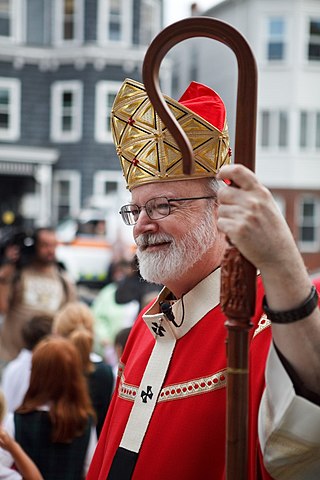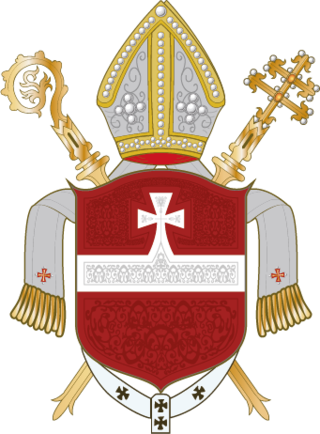Related Research Articles

There have been many cases of sexual abuse of children by priests, nuns, and other members of religious life in the Catholic Church. In the late 20th and early 21st centuries, the cases have involved many allegations, investigations, trials, convictions, acknowledgement and apologies by Church authorities, and revelations about decades of instances of abuse and attempts by Church officials to cover them up. The abused include mostly boys but also girls, some as young as three years old, with the majority between the ages of 11 and 14. Criminal cases for the most part do not cover sexual harassment of adults. The accusations of abuse and cover-ups began to receive public attention during the late 1980s. Many of these cases allege decades of abuse, frequently made by adults or older youths years after the abuse occurred. Cases have also been brought against members of the Catholic hierarchy who covered up sex abuse allegations and moved abusive priests to other parishes, where abuse continued.

Franz König was an Austrian Cardinal of the Catholic Church. He served as archbishop of Vienna from 1956 to 1985, and was elevated to the cardinalate in 1958. The last surviving cardinal elevated by Pope John XXIII, he was the longest-serving and second-oldest cardinal worldwide at the time of his death.

Stanisław Jan Dziwisz is a Polish prelate of the Catholic Church. He served as Metropolitan Archbishop of Kraków from 2005 until 2016. He was created a cardinal in 2006. He was a long-time and influential aide to Pope John Paul II, a friend of Pope Benedict XVI, and an ardent supporter of John Paul II's beatification.
Brendan Comiskey, is the Roman Catholic Bishop Emeritus of the Diocese of Ferns. He was born in Clontibret, County Monaghan, Ireland.

Hans Hermann Wilhelm Groër OSB was an Austrian Cardinal of the Roman Catholic Church. He served as Archbishop of Vienna from 1986 to 1995, and became a cardinal in 1988. Pope John Paul II replaced him as archbishop after multiple allegations of sexual abuse of children, and at John Paul's request Groër relinquished all ecclesiastical duties and privileges as an archbishop and cardinal on 14 April 1998.

Theodore Edgar McCarrick is a laicized American Catholic bishop, former cardinal, and former priest who served as Archbishop of Newark from 1986 to 2000 and as Archbishop of Washington from 2001 to 2006. In 2019, McCarrick was defrocked after having been convicted of sexual misconduct in a canonical trial.

Seán Patrick O'Malley is an American Catholic prelate who served as Archbishop of Boston from 2003 to 2024. He has served as president of the Pontifical Commission for the Protection of Minors since 2014. He is also a founding member of the Council of Cardinals, formed by Pope Francis 2013. A member of the Order of Friars Minor Capuchin, he was made a cardinal by Pope Benedict XVI in 2006.
Instruction Concerning the Criteria for the Discernment of Vocations with Regard to Persons with Homosexual Tendencies in View of Their Admission to the Seminary and to Holy Orders is a document published in November 2005 by the Congregation for Catholic Education, one of the top-level offices of the Catholic Church.

Keith Michael Patrick O'Brien was a senior-ranking Catholic prelate in Scotland. He was the Archbishop of Saint Andrews and Edinburgh from 1985 to 2013.

Michael Joseph Bransfield is an American prelate of the Roman Catholic Church. Bransfield served as bishop of the Diocese of Wheeling-Charleston in West Virginia from 2005 to 2018.
This page documents Catholic Church sexual abuse cases by country.

Kurt Krenn was an Austrian Roman Catholic prelate and Bishop of Sankt Pölten, near Vienna, from 1991 to 2004.
From the late 1980s, allegations of sexual abuse of children associated with Catholic institutions and clerics in several countries started to be the subject of sporadic, isolated reports. In Ireland, beginning in the 1990s, a series of criminal cases and Irish government enquiries established that hundreds of priests had abused thousands of children over decades. Six reports by the former National Board for Safeguarding Children in the Catholic Church established that six Irish priests had been convicted between 1975 and 2011. This has contributed to the secularisation of Ireland and to the decline in influence of the Catholic Church. Ireland held referendums to legalise same-sex marriage in 2015 and abortion in 2018.
The ecclesiastical response to Catholic sexual abuse cases is a major aspect of the academic literature surrounding the Catholic Church's child sexual abuse scandal. The Catholic Church's response to the scandal can be viewed on three levels: the diocesan level, the episcopal conference level and the Vatican. Responses to the scandal proceeded at all three levels in parallel with the higher levels becoming progressively more involved as the gravity of the problem became more apparent.
The media coverage of Catholic sex abuse cases is a major aspect of the academic literature surrounding the pederastic priest scandal.
The Catholic sexual abuse scandal in Europe has affected several dioceses in European nations. This article summarises reported cases of sexual abuse perpetrated by clergy and representatives of the Catholic Church by country and diocese.
The Murphy Report is the brief name of the report of a Commission of investigation conducted by the Irish government into the sexual abuse scandal in the Catholic archdiocese of Dublin. It was released in 2009 by Judge Yvonne Murphy, only a few months after the publication of the report of the Commission to Inquire into Child Abuse chaired by Sean Ryan, a similar inquiry which dealt with abuses in industrial schools controlled by Roman Catholic religious institutes.
The parish transfers of abusive Catholic priests, also known as priest shuffling, is a pastoral practice that has greatly contributed to the aggravation of Catholic Church sexual abuse cases. Some bishops have been heavily criticized for moving offending priests from parish to parish, where they still had personal contact with children, rather than seeking to have them permanently returned to the lay state by laicization. The Church was widely criticized when it was discovered that some bishops knew about some of the alleged crimes committed, but reassigned the accused instead of seeking to have them permanently removed from the priesthood.

The Austrian Bishops' Conference is the official assembly of the Roman Catholic bishops of Austria. It is the supreme authority of the Roman Catholic Church in Austria, established as a formal body under public law in 1849. Its members include the archbishops of Vienna and Salzburg, all diocesan and auxiliary bishops, as well as the abbot of immediate Wettingen-Mehrerau Abbey.

The Archiepiscopal Seminary of Vienna, commonly referred to in German as the Wiener Priesterseminar, is a Roman Catholic major seminary that serves as the seminary of the Archdiocese of Vienna. Founded in 1758 by the Archbishop of Vienna, Christoph Anton Migazzi, the seminary moved to its current building, the Haus Boltzmanngasse, in 1914. Today, the rector is Rev. Richard Tatzreiter and enrollment is 35.
References
- ↑ Obituary: Cardinal Hans Hermann Groer; Disgraced Archbishop of Vienna.(Obituaries) - The Independent (London, England) - HighBeam Research [ dead link ]
- ↑ "'Exile' for disgraced Austrian cardinal". BBC News. 1998-04-14. Retrieved 2010-05-23.
- ↑ Wiley, David (2004-10-07). "Pope replaces sex scandal bishop". BBC. Retrieved 2008-03-21.
- ↑ Horowitz, Jason (2004-10-08). "New Bishop After Seminary Sex Scandal". The New York Times . Retrieved 2008-03-22.
- ↑ "Sex Scandal At Austrian Seminary". Associated Press. 2004-07-13. Retrieved 2008-03-01.
- ↑ Pope orders Austria abuse inquiry
- ↑ Willey, David (October 7, 2004). "Pope replaces sex scandal bishop". BBC News. Retrieved February 6, 2012.
- ↑ Catholic Church losing members over sex scandals (Austria)